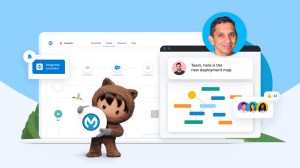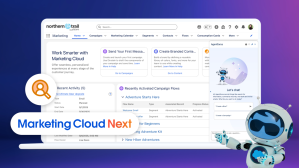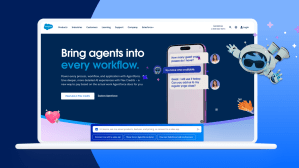As companies across the globe sprint to integrate AI into their operations, they need to ensure the technology is pulling from high-quality, trusted data sources. However, for a company’s data to be useful, it must first be reconciled into a real-time customer graph – or a unified customer profile.
Companies can then use their own proprietary, real-time data to power AI and automation across every line of business, providing highly personalized experiences across sales, service, marketing, and commerce that continuously adapt to changing customer information and needs.
The business need is more prevalent than ever as automation reduces the work that humans have to do on repetitive or monotonous tasks, which usually means a better experience for customers and lower stress for teams.
We caught up with Param Kahlon, Salesforce’s EVP and General Manager for Automation & Integration, to hear how MuleSoft helps customers connect data from any system to deliver personalized, AI-powered experiences.
Q. Why has generative AI become such a high priority for businesses — and so quickly?
It’s important to take a step back and ask, what is the role of AI in business? While there’s no one correct answer to this question, we must acknowledge its potential to make employees more efficient and improve customer experiences.
This is particularly important as research shows only 27% of companies are using AI tools to improve productivity and efficiency. On the other hand, businesses that have adopted AI are 90% more likely to report higher levels of productivity.
Q. How important is data integration in this AI “revolution”?
We are seeing companies struggle to tap into their best source of trusted data – their own. That’s because most companies’ data is siloed across many different systems, like CRMs, customer apps, or websites. To take full advantage of AI, companies must integrate these systems and harmonize their data.
To take full advantage of AI, companies must integrate these systems and harmonize their data.
MuleSoft’s integration products connect data silos across these various systems, improving generative AI’s outputs and ultimately, help drive more relevant and personalized interactions with customers.
Q. How can MuleSoft help with AI adoption?
With the dramatic developments in AI over the past year, we find ourselves at the forefront of this next transformation to meet customer needs and expectations. And those customers with strong integration and automation strategies are in the best position to put AI to work inside their organizations.
Q. Let’s dive further into the importance of data. What should companies consider when they start planning an AI+data strategy?
AI uses data to create algorithms that take action and make predictions. And for both predictive and generative AI, access to relevant and changing data is vital to its effectiveness. MuleSoft enables companies to unify all of their data, then connect that data to AI tools and services to deliver real-time, AI-driven results.
Whether you are training your own LLMs or grounding pre-trained models, having the right data at the right time is crucial to your AI application’s success. This challenge still exists today, but now there are pre-trained models to help jump start this process. So now, companies will be able to connect to these LLMs — their own or third party — and should provide security and governance.
Whether you are training your own LLMs or grounding pre-trained models, having the right data at the right time is crucial to your AI application’s success.
Also, trust is key when talking about data. Companies must make sure that the data they collect and store is from a secure source. And they have to ask themselves: Has the data been reviewed and audited? What’s the legitimacy of that data being inputted? Have you ensured PII and accessibility of data is compliant? All of the governance around the data is extremely important.
Q. Can you share an example of how a customer can use MuleSoft and AI?
Think about a customer applying for a new bank account — typically, a multi-step process with a massive paper trail. Imagine, instead of manual checking and processing, we employ automation and AI to shoulder this work.
Imagine, instead of manual checking and processing, we employ automation and AI to shoulder this work.
As soon as the application is submitted online, our Flow Orchestration automation tool steps in and checks for completeness, and fast-tracks work between people and departments by coordinating interrelated processes involving multiple teams into a single, streamlined workflow. Intelligent document processing then reads and extracts essential information from the documents, saving human time and effort.
Once the details are extracted, they can be consumed inside integrations in our next-gen integrated development environment (IDE), Anypoint Code Builder. This IDE is a software application that helps programmers develop software code efficiently to increase developer productivity by combining capabilities like software editing, building, testing, and packaging in an easy-to-use application. You don’t need to be a coder to instruct the system on what needs to be done next. Just talk to Einstein in simple language: “Give me a flow that creates a new account using this information and updates our internal mainframe system.” Einstein will provide a template flow, making it easier for the user to get started.
Plus business users can also build integrations and leverage custom connectors to services like LLMs in our low-code tool, MuleSoft Composer.
Q. What’s the interplay between AI and automation?
Automation is an integral part of a successful AI strategy. Our automation products support AI strategies in two key ways:
- We provide AI-driven automation and integration solutions so customers can automate their processes and boost productivity.
- We also provide API management solutions for customers to build AI-driven experiences – connecting systems and providing enterprise-level security and governance.
AI also enhances our automation solution. We’re exploring ways to increase productivity and reduce mundane tasks using generative AI to build automation flows using prompts. Process owners will be able to simply explain processes to the system in natural language. This will make automation quicker and more accessible for every user, not only developers.
Q. How does MuleSoft help make AI safer?
Trust is our number one value at Salesforce. We make sure that governance and security is applied to all AI capabilities we build into our products. Our new Einstein Trust Layer resolves concerns of risk associated with adopting generative AI. We want to build on that trust and extend our current MuleSoft Universal API management offering to enable customers to meet their enterprise data security and compliance demands within and outside of Salesforce.
For example, the Anypoint Flex Gateway allows you to manage, secure, and control your APIs — and thus, data movement — regardless of where it’s built and deployed. If you have specific use cases for how you want to protect and control your LLM APIs, you can also build custom policies to apply to the gateway. And Anypoint API Governance allows you to check for security conformance of each API. The foundational capabilities for safe and trusted APIs exist through Anypoint Platform, and now, we’re looking at AI-specific use cases to increase the scope of security and trust further to include AI APIs.
Learn more:
- Learn more about MuleSoft
- Explore how Einstein is supercharging customer experiences and company productivity with generative AI for the enterprise
- Learn more about Salesforce Data Cloud, the first real-time data platform for CRM, which today processes 30 trillion transactions per month, 1 trillion imports per day, and has hundreds of live customers across regions and industries
















